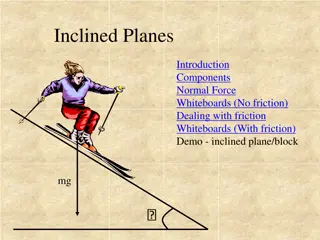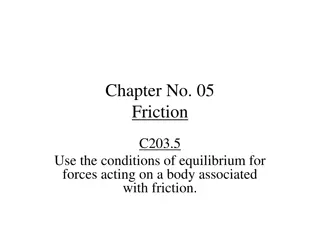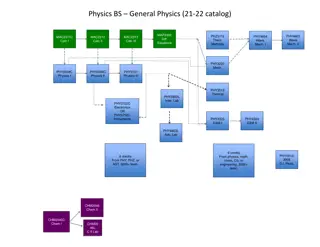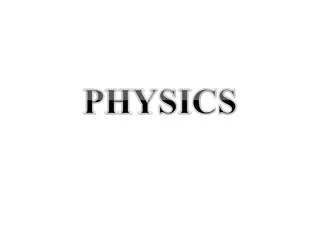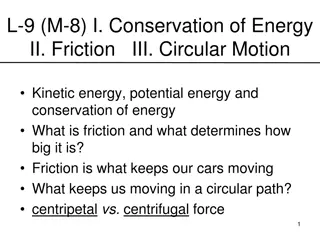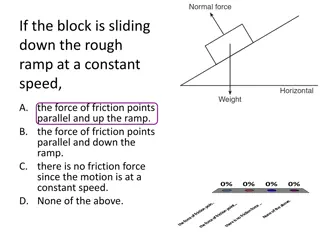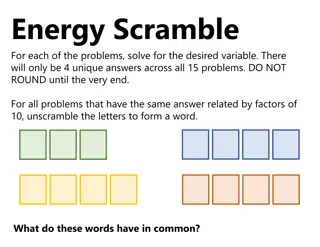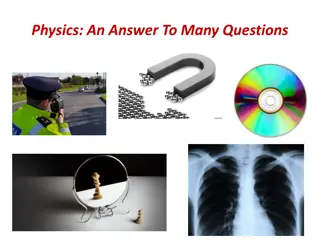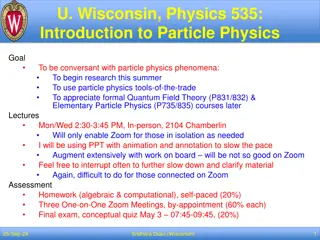Applications of Friction in Physics
Friction is a force that opposes motion and varies with materials and normal force. Learn about types of friction, coefficients, static friction, and solve example problems.
Download Presentation

Please find below an Image/Link to download the presentation.
The content on the website is provided AS IS for your information and personal use only. It may not be sold, licensed, or shared on other websites without obtaining consent from the author.If you encounter any issues during the download, it is possible that the publisher has removed the file from their server.
You are allowed to download the files provided on this website for personal or commercial use, subject to the condition that they are used lawfully. All files are the property of their respective owners.
The content on the website is provided AS IS for your information and personal use only. It may not be sold, licensed, or shared on other websites without obtaining consent from the author.
E N D
Presentation Transcript
Applications involving Friction CHAPTER 4 SEC 8
What is Friction? Friction is a FORCE that opposes or impedes the motion of an object. Friction is caused by microscopic bumps between solid objects in contact. Friction can exist from sliding objects or rolling objects (though rolling friction is less than sliding). Friction depends on the types of materials AND on the normal force (or weight) of the object.
Types of Friction Friction between solid objects sliding against each other (or rolling) is called Kinetic Friction. (Greek for moving) Friction between solid objects can exist parallel to the surface of them even when they are not moving. This is Static Friction. Each type of material changes the amount of Friction present, so we have a coefficient of friction, kor s, for kinetic and static coefficients. Friction depends very little on surface area.
Friction Coefficients The friction force, Ffr, is always perpendicular to the normal force, FN. In calculating kinetic friction: depends on whether the object is wet or dry, what type of finish is on them, but NOT on speed of the objects sliding. Ffr= kFN
Static Friction Static friction is a force that exists between objects that are in contact, but NOT moving when a force is applied. Eventually with a hard enough push, the object will move and kinetic friction takes over as you exceed the MAXIMUM static friction. Fmax= sFNand since static friction can vary from 0 to max, we write s is generally more than kas its harder to start an object than keep it moving. Ffr sFN
Example 1 A 10.0kg box rests on the floor. s = 0.4 and k =0.3 Determine the force of friction, Ffr, acting on the box if the horizontal applied force, FA= 20N. If FA= 40N. Draw a free body diagram and label all forces.
Solution for Example 1 In the vertical direction there is no motion, so the net force, fy= ma = 0 yields FN mg = 0. In all cases, the normal force, FN= mg = (10.0kg)(9.80m/s/s)= 98 N. The force of static friction will oppose any applied force up to the maximum of Ffr= sFN= (0.40)(98N)=39N If FA= 20 N, the box won t move so Ffr= -20N to balance the applied force.
FN FA Continued Ff Fg If FA= 40N, which is more than the maximum static friction force, the box will accelerate and we have kinetic friction, Ffr= kFN Ffr= (0.30)(98N) = 29 N. Fx= FA+ Ffr= 40 N + (-29N) = 11N, so the box will accelerate at a = Fnet/ mass. a = 11N / 10.0 kg = 1.1 m/s/s in a direction of the applied force. (positive horizontal).
More Examples Look at the Example 4-16 on page 99. (two boxes on a pulley) Now look at the Example 4-17 on page 100. (skier on a hill) Recall how to obtain components of weight when not perpendicular to the surface? FN is always perpendicular to the surface and Ffr is always parallel to the surface here.
Your turn to Practice Please do Chapter 4 Review p 107 #s 38 and 39 Please do Chapter 4 Review p 108 #s 40, 42, 43, 44, 46.



